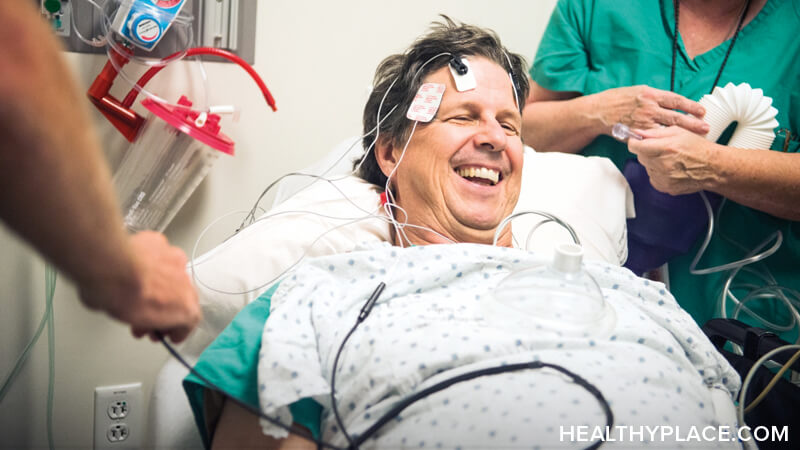Is Shock Treatment Still Used

"Shock therapy" was then-called, as an electric shock is used to induce a controlled seizure intended as a treatment, primarily for mood disorders, although other conditions may be treated every bit well. Shock therapy is now known every bit electroconvulsive therapy or ECT.
The brain is still not well understood, nor is the reason for the treatment effects ECT (daze) therapy has on some individuals. It is known that ECT affects hormones, neuropeptides, neurotrophic factors, and neurotransmitters in the encephalon. All of this may come together to explicate how ECT works in treatment.
Shock therapy was overused and misused in the past and since has come to have a mixed reputation (read about the history of ECT procedure). Great intendance is now taken to ensure ECT treatment is warranted, and signed consent must typically exist given earlier its use.
How to Prepare for a Daze Treatment
A full physical is by and large needed before shock therapy. Because general anesthesia will be administered, i should not consume or beverage 8-12 hours earlier the shock treatment. This helps to prevent any airsickness during the procedure. Other exams like an electrocardiogram (ECG) may as well be given before ECT to ensure the process is safety and appropriate.
How Shock Therapy is Performed
Shock therapy is performed in a infirmary, sometimes in an area specifically set bated for this treatment. An intravenous (IV) is inserted to provide coldhearted medication. Vital signs are taken initially and continuously throughout the shock therapy handling.
An anesthesiologist administers anesthesia and after you lot are comatose, places a tube in your throat to help you breathe. A paralyzing amanuensis called succinylcholine is then administered to prevent the seizure from spreading to your trunk. The electrodes are and so applied to your head with conducting jelly and a brief shock (less than 2 seconds) is administered.
How Shock Therapy Feels
When you awake from the anesthesia, you may be confused and tired. Yous will probable feel short-term retentivity loss around the time of the procedure. With multiple treatments, this may increase. Adverse cerebral effects tend to be the most concerning factors effectually ECT and tend to impact the frequency and duration of treatments and whether ECT is offered at all. Your vital signs will exist monitored closely after the shock treatment to ensure proper recovery. You lot may feel head, muscle or back hurting. Such discomfort tends to be relieved by mild medications. If any postal service-treatment effect is apropos you lot, you should talk to the treating doc immediately.
Why Shock Therapy is Performed
Information technology is most common to see shock therapy used in severe cases of depression. Shock therapy is as well performed to improve the status of the following disorders:1
- Acute mania
- Catatonia
- Occasionally, types of schizophrenia or other psychotic disorders
Electroconvulsive therapy has besides shown effectiveness in treating other disorders such as neuroleptic malignant syndrome (a rare, severe, adverse reaction to antipsychotic medication).
Shock treatment for depression and other disorders is indicated when the patient needs rapid improvement because the patient is:
- Suicidal
- Self-injurious
- Refusing to eat or beverage
- Refusing to have medication as prescribed
- A danger to themselves
- Psychotic
- Pregnant or otherwise tin't take standard medications
Some patients need maintenance ECT. Notice out why.
Risks Associated with Shock Therapy (ECT)
The complications associated with ECT / stupor therapy are oftentimes related to electrode placement with bilateral placement (an electrode past each temple) typically showing greater unwanted cognitive furnishings than unilateral placement (one electrode at the temple and the other on the forehead). Risks of daze therapy include deadening middle beat (bradycardia) and rapid heartbeat (tachycardia), also as retentivity loss, confusion and other cognitive effects. Persons at high adventure include those with recent heart attack, uncontrolled blood pressure, encephalon tumors and previous spinal injuries.
Read more comprehensive information well-nigh: ECT side effects.
Normal Results Afterward Shock Treatment
Daze treatment for depression frequently produces a dramatic improvement in symptoms, especially in elderly individuals, sometimes during the first week of handling. While it is estimated many of these patients will experience a hereafter return of low symptoms, the prognosis for each episode of depression is good. Mania as well oft responds well to shock handling. The motion-picture show is non as vivid for schizophrenia, which is more than difficult to care for and is characterized by frequent relapses.
A small number of patients are placed on maintenance shock therapy. This means they render to the hospital every ane-2 months, equally needed, for an boosted treatment. These individuals choose daze therapy because it tin can proceed their disease under control and help them lead a normal and productive life.
article references
APA Reference
Tracy, North. (2022, January 4). Shock Treatment for Depression: How ECT Daze Therapy Works, HealthyPlace. Retrieved on 2022, June 16 from https://www.healthyplace.com/depression/ect/stupor-handling-for-depression-how-ect-stupor-therapy-works
Is Shock Treatment Still Used,
Source: https://www.healthyplace.com/depression/ect/shock-treatment-for-depression-how-ect-shock-therapy-works
Posted by: powellsence1948.blogspot.com


0 Response to "Is Shock Treatment Still Used"
Post a Comment